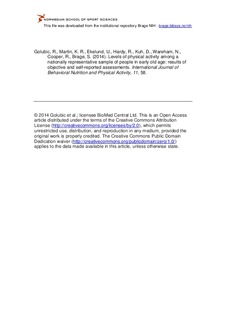| dc.contributor.author | Golubic, Rajna | |
| dc.contributor.author | Martin, Kathryn R. | |
| dc.contributor.author | Ekelund, Ulf | |
| dc.contributor.author | Hardy, Rebecca | |
| dc.contributor.author | Wareham, Nicholas J. | |
| dc.contributor.author | Cooper, Rachel | |
| dc.contributor.author | Brage, Søren | |
| dc.date.accessioned | 2015-06-01T12:14:59Z | |
| dc.date.available | 2015-06-01T12:14:59Z | |
| dc.date.issued | 2014-05-03 | |
| dc.identifier.citation | International Journal of Behavioral Nutrition and Physical Activity. 2014, 11, 58 | nb_NO |
| dc.identifier.uri | http://hdl.handle.net/11250/284355 | |
| dc.description | © 2014 Golubic et al.; licensee BioMed Central Ltd. | nb_NO |
| dc.description.abstract | Detailed assessment of physical activity (PA) in older adults is required to comprehensively describe habitual PA-levels in this growing population segment. Current evidence of population PA-levels is predominantly based on self-report.
Methods: We examined PA and sedentary behaviour in a nationally representative sample of British people aged 60–64, using individually-calibrated combined heart-rate and movement sensing and a validated questionnaire (EPAQ2), and the socio-demographic and behavioural factors that may explain between-individual variation in PA.
Results: Between 2006–2010, 2224 participants completed EPAQ2 capturing the past year’s activity in four domains (leisure, work, transportation and domestic life) and 1787 participants provided 2–5 days of combined-sensing data. According to objective estimates, median(IQR) physical activity energy expenditure (PAEE) was 33.5 (25.3-42.2) and 35.5 (26.6- 47.3) kJ/kg/day for women and men, respectively. Median (IQR) time spent in moderate-to-vigorous PA (MVPA; >3MET), light-intensity PA (1.5-3 MET) and sedentary (<1.5 MET) was 26.0 (12.3-48.1) min/day, 5.4 (4.2-6.7) h/day and 18.0 (16.6-19.4) h/day, respectively, in women; and 41.0 (18.8-73.0) min/day, 5.2 (4.0-6.5) h/day and 17.9 (16.3-19.4) h/day in men. PAEE and time spent in MVPA were lower and sedentary time was greater in obese individuals, those with poor health, and those with lower educational attainment (women only). Questionnaire-derived PAEE and MVPA tended to have similar patterns of variation across socio-demographic strata. In the whole sample, domestic PA had the greatest relative contribution to total questionnaire-derived PAEE (58%), whereas occupational PA was the main driver among employed participants (54%). Only 2.2% of participants achieved an average of >30 min MVPA per day combined with >60 min strength-training per week.
Conclusions: The use of both self-report and objective monitoring to assess PA in early old age provides important information on the domains of PA, PAEE and time spent at different intensity levels. Our findings suggest that PA levels are generally low and observed patterns of variation indicate specific subgroups who might benefit from targeted interventions to increase PA. | nb_NO |
| dc.language.iso | eng | nb_NO |
| dc.publisher | BioMed Central | nb_NO |
| dc.subject | physical activity | nb_NO |
| dc.subject | sedentary behaviour | nb_NO |
| dc.subject | physical activity questionnaire | nb_NO |
| dc.subject | combined sensing | nb_NO |
| dc.subject | birth cohort | nb_NO |
| dc.subject | old age | nb_NO |
| dc.title | Levels of physical activity among a nationally representative sample of people in early old age: results of objective and self-reported assessments | nb_NO |
| dc.type | Journal article | nb_NO |
| dc.type | Peer reviewed | nb_NO |
| dc.subject.nsi | VDP::Social science: 200::Social science in sports: 330 | nb_NO |
| dc.subject.nsi | VDP::Medical disciplines: 700::Sports medicine: 850 | nb_NO |
| dc.source.journal | International Journal of Behavioral Nutrition and Physical Activity | nb_NO |
| dc.description.localcode | Seksjon for idretssmedisinske fag / Department of Sports Medicine | nb_NO |
